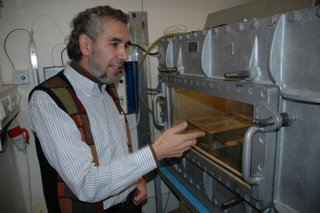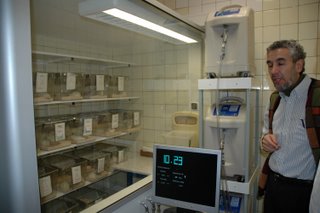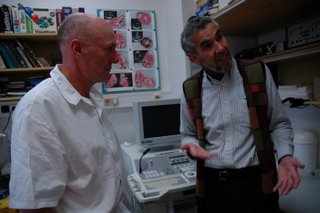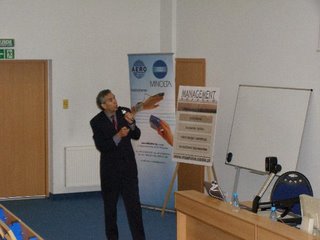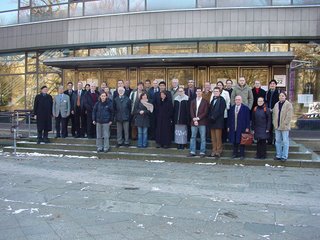Energy-efficient space travel alternative: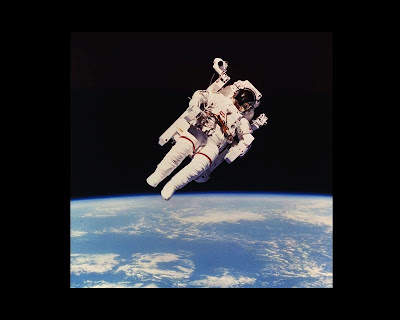
Hypobaric cabin pressure?
Gustavo Zubieta-Calleja (Jr)
The Panum Institute, Faculty of Health Sciences, University of Copenhagen
High Altitude Pathology Institute, Clinica IPPA. http://www.Altitudeclinic.com. La Paz, Bolivia
The following comments are conclusions of a “Doctor of Medical Sciences” dissertation, presented to the University of Copenhagen, entitled “Human Adaptation to High Altitude and Sea Level; Acid-Base Equilibrium, Ventilation and Circulation in Chronic Hypoxia” accepted for assessment on Sept 7th, 2007.
Based on 36 years of research related to high altitude polycythemia with Prof. Gustavo Zubieta-Castillo (Sr) in Bolivia and recently high altitude to sea level adaptation with Prof. Poul-Erik Paulev in Denmark, a greater understanding of the hematologic response to inspired oxygen pressure changes has led to the following:
Astronauts in the micro-gravity environment of space suffer many changes and among those anemia [1]. Thus far unexplained, neocytolisis has been described as the possible underlying mechanism [2, 3]. The adaptation to micro-gravity involves less use of muscle work and changes in ventilation and perfusion at lung level that the organism finds convenient to reduce the hematocrit following the least energy expenditure concept [4]. The knowledge and understanding of physiologic polycythemia (now known as polyerythrocythemia) upon ascent to high altitude and relative anemia following descent of high altitude residents to sea level [5, 6], allows for a logical proposal to bloodletting of high altitude residents on travel to sea level for periods longer than 20 days (an outstanding humanitarian blood resource) and similarly in astronauts when going into space. The logic is that they would economize energy avoiding the destructive hemolytic phase of adaptation. However, in astronauts, upon return to sea level, re-infusion of the phlebotomized blood could return the hematocrit to normal levels, although blood transfusion efficiency has lately been questioned. Erythropoyetine administration is also a possibility but less physiologic, more complicated and time limited.
Original space flights were carried out in a pure oxygen environment and one third the sea level pressure until serious fire accidents were encountered. Currently, the cabin pressure is normal sea level pressure at 760 mmHg with 20 % oxygen and 80 % nitrogen [7].
An alternative to the complication of space travel anemia would be to reduce the ambient oxygen tension within space vehicles, down to 2/3 the sea level pressure to around 495 mmHg (similar to the altitude of the city of La Paz with over 1.5 million inhabitants), in order to maintain a hypoxic stimulus and sustain the number of red blood cells for re-entry to Earth. Furthermore, the weightlessness space conditions require less oxygen consumption as there is less muscular use and hence tolerance to hypoxia can be increased. After an uncomplicated acute adaptation phase to hypoxia, with the adequate procedures, the astronauts can proceed with their normal routine during space travel. Upon return to sea level and the “relative hyperoxia”, the blood count should remain unchanged. This would create important advantages as there would be lower need for oxygen generation and pressure build-up, both high energy consumption processes. Likewise the Extravehicular Mobility Unit could benefit from a lower oxygen tension, less pressure difference with the space capsule, a speedier preparation and additionally more autonomy. Long space flights in the near future, would require less wasted resources in excess oxygen production and pressure. The return to the normal (relative hyperoxic) environment of sea level, would ease adaptation, as there would have been no reduction of the hematocrit during space flight [8]. Man faces future space travel where oxygen tensions will be a crucial life saving variable, and this proposal provides a physiological and physical energy-efficient alternative.
References
[1] Tavassoli M. Anemia of spaceflight. Blood. 1982 Nov;60(5):1059-67.
[2] De Santo NG, Cirillo M, Kirsch KA, Correale G, Drummer C, Frassl W, et al. Anemia and erythropoietin in space flights. Semin Nephrol. 2005 Nov;25(6):379-87.
[3] Rice L, Alfrey CP. The negative regulation of red cell mass by neocytolysis: physiologic and pathophysiologic manifestations. Cell Physiol Biochem. 2005;15(6):245-50.
[4] Zubieta-Calleja GR, Paulev PE, Zubieta-Calleja L, Zubieta-Calleja N, Zubieta-Castillo G. Hypoventilation in chronic mountain sickness: a mechanism to preserve energy. J Physiol Pharmacol. 2006 Sep;57 Suppl 4:425-30.
[5] Zubieta-Calleja GR, Paulev P-E, Zubieta-Calleja L, Zubieta-Castillo G. Altitude adaptation through hematocrit changes. J of Physiol and Pharmacol. 2007;58(Supplement in print).
[6] Zubieta-Castillo G, Sr., Zubieta-Calleja GR, Jr., Zubieta-Calleja L. Chronic mountain sickness: the reaction of physical disorders to chronic hypoxia. J Physiol Pharmacol. 2006 Sep;57 Suppl 4(2):431-42.
[7] NASA. Crew Compartment Cabin Pressurization. [cited 2007 June15, 2007]; Available from: http://spaceflight.nasa.gov/shuttle/reference/shutref/orbiter/eclss/cabinpress.html
[8] Zubieta-Calleja GR. Human adaptation to high altitude and to sea level: Acid-base equilibrium, ventilation, and circulation in chronic hypoxia. [Dissertation]. Copenhagen: University of Copenhagen; Sept 7th, 2007.
Photo courtesy of NASA, downloaded from http://www.geekphilosopher.com/MainPage/bkgStars.htm






